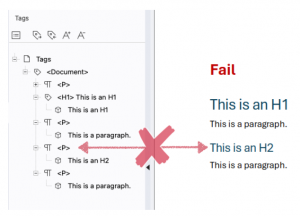Techniques for Accessible PDF: Headings
The 2025-Q2 release of Techniques for Accessible PDF focuses on headings, with 9 new techniques and 7 new failure examples.
WINCHESTER, MA, UNITED STATES, April 22, 2025 /EINPresswire.com/ -- The PDF Association is pleased to announce its second release of Techniques for Accessible PDF by the PDF Accessibility Liaison Working Group. Following the January 2025 announcement of the original set of fundamental techniques, the 2025-Q2 release focuses on headings, with nine new pass techniques and eight new failure examples, expanding significantly on the existing guidance.Headings are vital in organizing document content, especially with longer or complex documents. For assistive technology, the correct use of headings allows what would otherwise be an undifferentiated stream of text to become a navigable document in which readers can quickly find the content they want to read, and skip the content they don’t want to read.
The new Techniques for headings provide essential examples of correct and incorrect use of these document-structuring tags in the PDF context.
Getting headings right in PDF is especially important, as PDF files can be very long documents, possibly including deeply nested headings. PDF files can also contain multiple documents and / or subsections of other documents. Accordingly, techniques for headings in PDF files differ from techniques that are applicable to other technologies such as HTML.
This vendor-neutral information, combined with precise, fully-functional example files, provides a basis for precise, authoritative test results while ensuring software developers retain maximum flexibility and potential for innovation. The objective is to help software developers, document authors and remediators to arrive at a common understanding of how to meet the needs of users who rely on assistive technology in order to read.
The following techniques provide formal examples representing the correct expression of headings in accessible PDF files:
PDF118 H_01 First-level heading correctly tagged as H1
PDF119 H_02 Multiline heading correctly tagged
PDF120 H_03 Headings with different levels correctly tagged
PDF121 H_04 Image used as heading correctly tagged
PDF122 H_05 Heading levels correctly not skipped
PDF123 H_06 Subtitle correctly tagged
PDF124 H_07 Title in page content correctly tagged
PDF125 H_08 Heading level 7 correctly role mapped to P
PDF126 H_09 Heading level 7 correctly role mapped to H6
The following examples indicate specific failures in the representation of headings in the PDF context:
PDF-F23 H_F01 First-level heading incorrectly tagged as P instead of H1
PDF-F24 H_F02 Multiline heading incorrectly tagged
PDF-F25 H_F03 Paragraph incorrectly tagged as H2
PDF-F26 H_F04 Incorrect use of headings instead of table header cells
PDF-F28 H_F06 Incorrect combined use of Hn and H tags for headings
PDF-F29 H_F07 Both title and top level headings incorrectly tagged as H1
PDF-F30 H_F08 Heading level incorrectly skipped
This approach enables all users – authors, remediators, auditors, and software developers – to arrive at a common understanding.
Many additional techniques specific to individual use cases (e.g., tables and lists) are in development. The LWG plans to maintain a quarterly release cycle going forward.
About the PDF Accessibility LWG: Led by co-chairs Markus Erle, (axes4), Birgit Peböck (Barrierefrei PDF OG) and Zak Kinsey (TargetStream Technologies), the PDF Accessibility Liaison Working Group (LWG) was originally formed to continue the work started at the PDF Techniques Accessibility Summit in December 2018; producing industry-supported example PDF files demonstrating techniques for achieving accessible PDF.
Press inquiries: Contact Duff Johnson at duff.johnson@pdfa.org
Duff Johnson
PDF Association
+1 617-283-4226
email us here
Visit us on social media:
LinkedIn
Legal Disclaimer:
EIN Presswire provides this news content "as is" without warranty of any kind. We do not accept any responsibility or liability for the accuracy, content, images, videos, licenses, completeness, legality, or reliability of the information contained in this article. If you have any complaints or copyright issues related to this article, kindly contact the author above.
Knowledge Pillars and Certiport Launch Strategic Global Partnership to Expand Hands-On WordPress Certification
SkyLink Technologies Joins KAUST Technology Park to Drive Innovation in Micro-Positioning and Global Communication
ProSat Networks Announces Starlink Internet Installation for RV Parks & Resorts with Blazing Fast WiFi Across USA
Kalendarium
Więcej ważnych informacji
 Jedynka Newserii
Jedynka Newserii

 Jedynka Newserii
Jedynka Newserii

Prawo

KE proponuje nowy Fundusz Konkurencyjności. Ma pobudzić inwestycje w strategiczne dla Europy technologie
W środę 16 lipca Komisja Europejska przedstawiła projekt budżetu na lata 2028–2034. Jedna z propozycji zakłada utworzenie Europejskiego Funduszu Konkurencyjności o wartości ponad 400 mld euro, który ma pobudzić inwestycje w technologie strategiczne dla jednolitego rynku. Wśród wspieranych obszarów znalazła się obronność i przestrzeń kosmiczna. Na ten cel ma trafić ponad 130 mld euro, pięciokrotnie więcej niż do tej pory.
Firma
Były prezes PGE: OZE potrzebuje wsparcia magazynów energii. To temat traktowany po macoszemu

Choć udział odnawialnych źródeł energii w miksie energetycznym Polski jest stosunkowo wysoki i rośnie, to ten przyrost jest chaotyczny i nierównomiernie rozłożony miedzy technologiami – wskazuje Forum Energii. Dodatkowo OZE potrzebują wsparcia magazynów energii, a zdaniem Wojciecha Dąbrowskiego, prezesa Fundacji SET, ten temat jest traktowany po macoszemu. Brak magazynów powoduje, że produkcja energii z OZE jest tymczasowo wyłączana, co oznacza marnowanie potencjału tych źródeł.
Infrastruktura
Wzrost wynagrodzeń ekip budowlanych najmocniej wpływa na koszty budowy domu. Zainteresowanie inwestorów mimo to nieznacznie wzrasta

Budowa metra kwadratowego domu w Polsce kosztuje od 5,55 do 6 tys. zł w zależności od województwa – wynika z najnowszych analiz firmy Sekocenbud. Najdrożej jest w Warszawie, gdzie cena za metr kwadratowy domu przekroczyła już 6,2 tys. zł. Na przyrosty kosztów budowy domu wpływają zarówno drożejące materiały budowlane, jak i wyższe wynagrodzenia pracowników. Inwestorzy nie rezygnują jednak z budowy domów jednorodzinnych, co ma związek m.in. z wciąż wysokimi cenami mieszkań czy też obniżką stóp procentowych.
Partner serwisu
Szkolenia

Akademia Newserii
Akademia Newserii to projekt, w ramach którego najlepsi polscy dziennikarze biznesowi, giełdowi oraz lifestylowi, a także szkoleniowcy z wieloletnim doświadczeniem dzielą się swoją wiedzą nt. pracy z mediami.









.gif)

 |
| |
| |
|